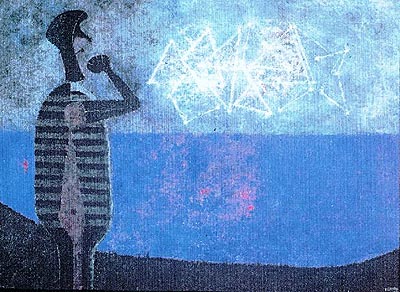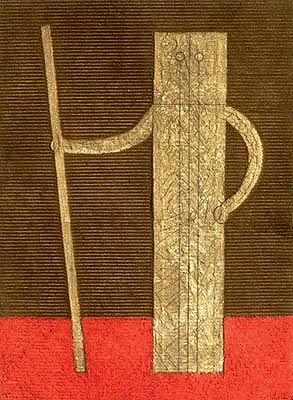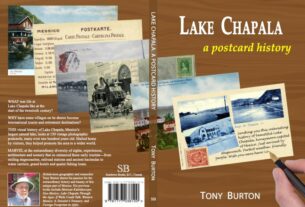Arts of Mexico
I’ve just recently seen the ” Tamayo Illustrador” exhibition at the Museo del Periodismo y las Artes Graficas in downtown Guadalajara. Rufino Tamayo is a Mexican icon, and this was one show I didn’t want to miss.
I wasn’t disappointed. Though my first introduction to Tamayo was through his magical, richly textured oils, I found myself equally absorbed in the lithographs and illustrations that were presented in the show. It is remarkable that in whatever media Tamayo applied himself, his illusive energy that binds us all comes through the work. This extraordinary ability to touch the heart of his viewer is as evident in his greeting cards, public announcements, illustrations of literary works, and text book covers – where but in Mexico does the Board of Education commission a world class painter to illustrate its textbooks.- as it is in his easel paintings and murals.
An interesting aspect of the show was that much of the work would have been ephemeral if not for the happenstance of a few libraries and archives. I felt privileged that much of this work has been saved. It gave me a chance to see not only the breadth of Tamayo’s work, but the context in which it was done.
A number of the exhibits really grabbed my interest. Among them were the drawings he did for ” Mexican Folkways“, a now defunct bilingual magazine of art, archeology, legends, festivals, and song. The magazine was a cultural celebration of Mexico in its time, and the quality of its artwork and writing have yet to be matched. I was disappointed it was no longer in print when I came to Mexico. To finally see copies of the magazine that I had read so much about along with the Tamayo illustrations was an unexpected delight.
I was also taken by the five lithographs he did in 1975 to illustrate ” Los Signos Existen“, a poem by Mexican poet, Miguel Angel Asturias. It was obvious from the illustrations that the poems had to do with the symbolic language of myths, and no other painter could have caught the subtle language of this “other” world better than Tamayo.
The exhibit that most caught my attention was a series of lithographs on handmade paper that were commissioned by the Spanish government in 1984 to pay homage to Fray Bartolome de las Casas. De las Cases, a Spanish monk born in Seville, passionately defended the rights of the Indians in the New World. Spain decided to honor his 500th birthday by asking a group of well-known Spanish and “new world” artists, Tamayo among them, to Illustrate the Universal Declaration of Human Rights. Tamayo’s illustrations, so simply done in reds, blues, and black, were so filled with passion and raw power that I felt compelled to keep returning them again and again for the length of time I was at the exhibit.
I was surprised at the number of books he had illustrated. His illustrations showed great respect for the writer. They weren’t stories or narrations competing with the writer but a type of hieroglyphic that symbolized and surrounded the essence of the writer’s work. Their main purpose seemed to be to esthetically enrich the books offering an invitation in. And yet, while he was always at the service of the text, the quality of the work rose above mere illustration. His illustrations have the look of small paintings that could be hung on walls.
The exhibit opened with a wonderful collection of photographs taken at different times throughout Tamayo’s life. There were pictures of him as a young man, pictures of him with his wife, and even one with Picasso when he came to visit him in Mexico. There were some excellent ones of him in juxtaposition to his enormous indigenous art collection, and there was a very powerful one of him as late as 1989 when he was already 90 years old, still vigorous and working in his studio. In fact, he worked to the day he died in 1991 having just completed his last painting, ” Boy With a Violin“.
This intelligently put together photographic display revealed a man connected to his time and well-placed in the context of his country’s history. His interest in and connection to the art movements of the day totally dispell the myth of the uneducated Zapotec Indian. He certainly had a passion for pre-Columbian art, and it was fundamental to his paintings, but in truth, he was of mixed blood and educated.
Life began for Rufino Tamayo on August 26, 1899, in Oaxaca, Mexico. He was orphaned by 1911 and was sent to Mexico City to live with an aunt who ran a wholesale fruit business. The aunt eventually withdrew him from school because he spent most of his time drawing, and he worked for a while in her fruit stand.
He entered the San Carlos Academy in 1917 and was there until 1921 when he was appointed head of the Department of Ethnographical Drawing at the National Museum of Archeology. It was here that he was able to study pre-Columbian sculpture and Mexican folk art in depth. The experience exposed him to much of the native art forms, which nourished his painting throughout most of his life. In his early paintings you can already see the forms and slate tones of pre-Columbian ceramics in his still lifes and portraits of Mexican men and women.
Tamayo rebelled against the classical style of art taught at the Academy and looked to the modern schools developing in Europe, especially Fauvism and Cubism. From the cubists he incorporated a perception of multiple perspectives and from the fauvists a new way of perceiving color and the free treatment of form.
But within these parameters his personal vision quickly developed, and his subjects, however abstractly treated, were imbued with a Mexican core. He looked for the soul of his country in the sculptures of pre-Hispanic America, and his color owed nothing to the European artists who interested him. They reflected the sky, earth, and landscape of Mexico as well as the dyes used in Mexican clothes.
He also differed with the muralists. While his contemporaries were advocating art with a message, Tamayo focused on plastic forms integrated with colors and textures. He had a great aversion to art that “educated” and wasn’t interested in following the representational style favored by most of the early Muralists. “Spirit and soul,” he said, ” are still valid beneath our mechanized, over-hyped societal structures”, and he strove to follow a vision of art that was more universal.
He found political art oppressive and escaped to New York where he lived on and off for the next 20 years. New York’s openness to experimentation in art gave Tamayo the freedom he needed to work out his question of identity. He immersed himself in studying the mythology of pre-Hispanic cultures, and his understanding of their way of perceiving the world shaped his own vision of man’s place in the cosmos.

Two distinctive features of pre-Columbian art started to emerge in his work – the geometric conception of form and the symbolic or metaphysical function of images. He started to juxtapose or distort images in such a way that it contradicted our normal expectations. He stretched the norms of perceived reality and brought us into a world where the implausible became plausible. Within the symbolic imagery of his forms, rich and brilliant colors were imposed on complex textures. He laid the foundation of magic realism, which continues to influence artist throughout Latin America.

In the 1940s he traveled to Europe for the first time to exhibit in Paris, London, and Rome. Along with various murals done in the 1950s and 1960s, his reputation escalated from national to international.
In 1964 he returned home for good. During that decade Luis Remba approached him with the idea of making prints. Tamayo was only interested if he could produce editions that possessed the same kinds of volume, texture, and depth as in his paintings. Together they developed new tools and machinery that permitted them to integrate colors and textures and fuse them in the paper. This technique came to be known as mixografia, and Tamayo produced some extraordinary work with it.
In 1974, Tamayo donated his entire collection of pre-Hispanic art to his native city, Oaxaca. All 1300 pieces are housed in the Rufino Tamayo Museum of Pre-Hispanic Art. When he died in 1991. his remains were put to rest in this splendid museum. It seems fitting that the man should be interred along with the great cultural legacy he left behind, not only the artifacts but the great body of work he himself produced that honored this heritage.
Rufino Tamayo was a man of few words but with remarkable clarity of vision. Throughout his lifetime he remained fiercely committed to painting as a spiritual activity, and he bravely defended his pursuit of what he called the ” Mexican tradition”. Yet, his language was so universal, so timeless, that people from every country in the world respond to his paintings. There’s little doubt they will continue to do so for generations to come.
Rufino Tamayo – Books
- Yo Miro, Miro Todo El Tiempo: Basado En Pinturas Y Textos De Rufino Tamayo by Claudia Burr Muro published 2001 by Editiones Tecolote
- Rufino-Tamayo – Pinturas by Rufino Tamayo published 1997
- Rufino Tamayo by Jacques Lassaigne, published 1982 and 1995 by Rizzoli
- Rufino Tamayo by Lassaigne Paz published 1992 by Ediciones Poligrafa S.A.
- Tamayo by Jose Corredor Matheos published 1987 by Rizzoli
- Rufino Tamayo by Robert John Goldwater
- Rufino Tamayo by Emily Genauer, Published by Harry N. Abrams, Inc.
Rufino Tamayo – Chronology
- 1899 Born in the state of Oaxaca on August 26
- 1911 Orphaned and sent to live with aunt in Mexico City
- 1915 Began taking drawing lessons
- 1917 Entered San Carlos Academy
- 1921 Appointed head of the Department of Ethnographic Drawing at the Museo Nacional de Arqueologia
- 1926 First exhibition at the Weyhe Gallery in New York City
- 1929 Returned to Mexico City as a professor at the School of Fine Arts
- 1933 Decorated, al fresco, for the stairway of the National Conservatory of Music in Mexico City. Mural a clear expression of his capacity to impart plastic values to abstract elements – a rare trait in mural painting.
- 1934 Exhibited at the Mexican Art Gallery in Mexico City where work elicited great interest among critics and artists.
- 1936 Moved to New York and throughout the late thirties and early forties showed at the Valentine Gallery
- 1938 Taught art at Dalton School and Brooklyn Museum in New York City
- 1948 First retrospective at the Instituto de Bellas Artes in Mexico City
- 1949 First trip to Europe where he exhibited in Paris, London, and Rome
- 1952 Commissioned to do two murals at the Palacio de Bellas Artes de Mexico in Mexico City.
- 1956 Named Chevalier and Officer de la Legion d’Honneur by the French government
- 1952 First prize at Carnegie International, Pittsburgh
- 1953 First prize in the 2nd Bienal in San Paulo, Brazil.
- 1957 Decorated Chevalier de la Legion d’Honneur by French government Settled in Paris where he would remain for seven years.
- 1958 Executed a mural for the UNESCO Building in Paris
- 1959 Nominated Member of the Academy of Arts, Buenos Aires
- 1960 Guggenheim International Foundation Award
- 1961 Elected member of the American Academy of Arts and Letters
- 1964 National Award from the President of the Republic of Mexico Returned to Mexico permanently
- 1969 Calouste Gulbenkian Prize, French Institute, Paris
- 1970 Decorated Officer de la Legion d’Honneur by French government
- 1971 Decorated Commendatore of the Italian Republic
- 1972 Nominated Member of the Academy of Arts, Buenos Aires
- 1974 Inaugurated the Museo de Arte Prehispanico Rufino Tamayo in his native city of Oaxaca, which houses his 1300 piece collection of pre-Hispanic art.
- 1975 Began working at the Mixografia Workshop in Mexico City where he combined molded relief printing with lithography.
- 1977 Retrospective at the Sao Paulo Bienal
- 1978 Retrospective at the Solomon R. Guggenheim Museum in New York
- 1979 Worked at Ediciones Poligrafa in Barcelona combining copper plates sculpted with epoxy resins and etching.
- 1980s Director of the Fine Arts School at the Benito Juarez. Autonomous University in Oaxaca.
- 1981 Donated the Rufino Tamayo Museum of Contemporary Art, one of the more modern centers of contemporary art in the world, to Mexico City
- 1983 Albert Einstein award from Technion Institute, Israel
- 1990 Completed his last canvas, ” El muchacho de violon“
- .1991 Died on June 24 in Mexico City

